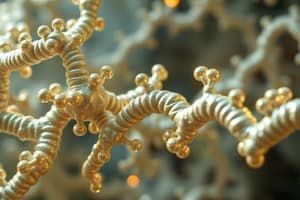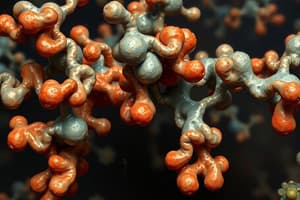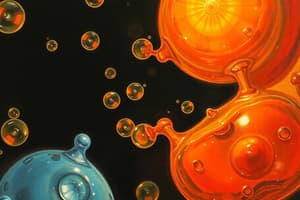Podcast
Questions and Answers
What is the primary role of enzymes in biochemical reactions?
What is the primary role of enzymes in biochemical reactions?
- Alter the structure of the substrates
- Increase the temperature of the reaction
- Lower the activation energy of the reactions (correct)
- Increase the substrate concentration
Which statement accurately describes the induced fit model?
Which statement accurately describes the induced fit model?
- Only one type of substrate can fit into an enzyme's active site
- The enzyme's active site changes shape to accommodate the substrate (correct)
- Substrates can bind without any change in enzyme structure
- Enzymes remain unchanged after the reaction
What effect does increasing enzyme concentration have on the rate of reaction?
What effect does increasing enzyme concentration have on the rate of reaction?
- It decreases the activation energy required
- It has no effect regardless of substrate concentration
- It increases the rate until substrate concentration becomes limiting (correct)
- It will always decrease the rate of reaction
Which of the following describes an irreversible inhibitor?
Which of the following describes an irreversible inhibitor?
What happens to the rate of reaction when substrate concentration is increased beyond a certain point?
What happens to the rate of reaction when substrate concentration is increased beyond a certain point?
Which factor does NOT affect the performance of enzymes?
Which factor does NOT affect the performance of enzymes?
Which type of inhibitor binds to the active site through weak interactions and is not permanent?
Which type of inhibitor binds to the active site through weak interactions and is not permanent?
How do heavy metal ions, as irreversible inhibitors, affect enzyme activity?
How do heavy metal ions, as irreversible inhibitors, affect enzyme activity?
What is the primary mechanism by which competitive inhibitors affect enzyme activity?
What is the primary mechanism by which competitive inhibitors affect enzyme activity?
Which of the following correctly describes the effect of increasing substrate concentration on non-competitive inhibition?
Which of the following correctly describes the effect of increasing substrate concentration on non-competitive inhibition?
What role do coenzymes play in enzyme activity?
What role do coenzymes play in enzyme activity?
Which of the following statements is true regarding enzymes and their cofactors?
Which of the following statements is true regarding enzymes and their cofactors?
What distinguishes prosthetic groups from other types of cofactors?
What distinguishes prosthetic groups from other types of cofactors?
How does penicillin function as an inhibitor?
How does penicillin function as an inhibitor?
Which of the following is a characteristic of activators?
Which of the following is a characteristic of activators?
What is the effect of a higher concentration of a competitive inhibitor on enzyme activity?
What is the effect of a higher concentration of a competitive inhibitor on enzyme activity?
Flashcards are hidden until you start studying
Study Notes
Enzymes
- Enzymes are biological catalysts that speed up chemical reactions by lowering the activation energy.
- The active site is a specific region on an enzyme where the substrate binds.
- Enzymes are highly specific to their substrates, meaning only one type of substrate fits into the active site.
- The induced fit model explains how the enzyme's active site changes shape upon substrate binding to fit perfectly.
Factors Affecting Enzyme Activity
- Enzyme Concentration: Increasing enzyme concentration increases the rate of reaction up to a point where substrate concentration becomes the limiting factor.
- Substrate Concentration: Increasing substrate concentration increases the rate of reaction until enzyme saturation occurs, making enzyme concentration the limiting factor.
- Temperature: Enzyme activity increases with temperature until reaching an optimum temperature, beyond which the enzyme denatures and activity decreases.
Inhibitors
- Inhibitors are substances that slow down or stop enzyme activity by interfering with substrate binding.
- Irreversible inhibitors permanently alter the enzyme's structure, such as heavy metal ions like mercury and silver which break disulphide bonds.
- Reversible inhibitors bind temporarily to the enzyme and can be categorized as competitive or non-competitive.
- Competitive inhibitors bind to the active site, competing with the substrate. Increasing substrate concentration can overcome competitive inhibition.
- Non-competitive inhibitors bind to an allosteric site, changing the active site shape and preventing substrate binding. Increasing substrate concentration does not affect non-competitive inhibition.
Examples of Inhibitors as Drugs
- Penicillin inhibits bacterial enzyme transpeptidase, crucial for cell wall formation, leading to bacterial death.
- Ritonavir inhibits HIV protease, preventing the assembly of new viral particles and inhibiting the spread of HIV infection.
Cofactors
- Cofactors are non-protein molecules essential for enzyme activity.
- Coenzymes are organic cofactors that bind temporarily to the enzyme and facilitate substrate binding. Many are vitamin-derived, like NAD (derived from niacin) acting as a hydrogen acceptor.
- Activators are inorganic metal ions that bind temporarily to the enzyme, altering the active site and promoting the reaction. For example, magnesium ions shield negative charges.
- Prosthetic groups are permanently attached to the enzyme. For example, the haem group in haemoglobin contains iron, which permanently binds oxygen.
Studying That Suits You
Use AI to generate personalized quizzes and flashcards to suit your learning preferences.




